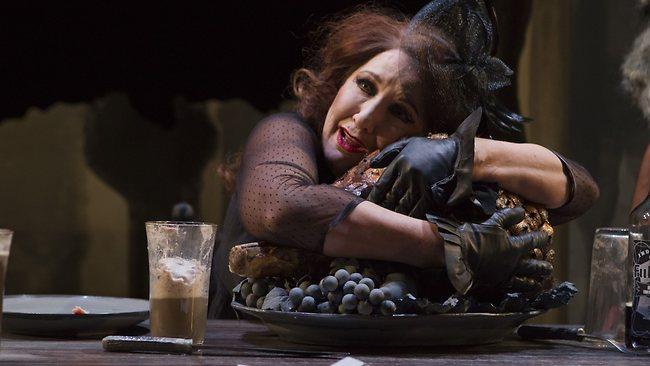Patrick White revival signals a new chapter for Australian literary classics
WHILE Patrick White is enjoying a posthumous revival, other prize-winning Australian authors have been neglected. But there is hope.

IN 1977, Patrick White, then in his mid-60s, scribbled a note in blue ink to the National Library of Australia in Canberra. In his sprawling, untidy hand, Australia's only home-grown Nobel prize-winner in literature declared with customary crankiness: "I can't let you have my 'papers', because I don't keep any . . . Anything unfinished when I die is to be burnt."
Despite White's frosty and dismissive tone, that same note features prominently in a new exhibition at the National Library, called The Life of Patrick White. Held to mark the centenary of White's birth - he was born in London on May 28, 1912 - the exhibition celebrates the writer's life through objects as diverse as the Nobel laureate's childhood silver cutlery set, his Nobel prize medal and the manuscript for his recently discovered incomplete novel, The Hanging Garden, which has just been published to wide acclaim.
The library's director of exhibitions, Nat Williams, says the exhibition offers the public, for the first time, an overview of the library's vast collection of White's papers, which it acquired in 2006. White's repeated insistence that he burned his notebooks and manuscripts turned out to be one of his more elaborate fictions: six years ago, his literary agent Barbara Mobbs offered the National Library a trove of the writer's papers, letters and photographs, which the institution snapped up.
The aim of the exhibition, Williams says, is to present a multidimensional picture of an artist almost as renowned for his unforgiving temperament as for his fiction. "What we are trying to get across is that he was much more complex than that," he says. The exhibition is among the miscellany of events being held this year to mark White's centenary. Noting how publication of The Hanging Garden will win him new readers, Williams argues that "White's moment has arrived again".
Certainly, the White revival contrasts starkly with the years following the author's death in 1990, when his works weren't widely taught in schools and universities, his prose deemed too dense and difficult. The nadir came in 2006 when this newspaper submitted under a pseudonym a chapter from White's The Eye of the Storm to publishers and literary agents. It was roundly rejected, and one publishing figure urged the author to read a how-to guide on writing fiction.
If White is enjoying posthumous acclaim, a plethora of other Australian literary classics are in danger of being virtually wiped from the cultural map. Alarmed at the trend, leading publishers are poised to launch new, ambitious series of neglected local works, among them one-time muscular bestsellers, literary prize-winners and novels that were turned into popular films.
This month, Melbourne publishing house Text is releasing a series of 30 Australian classics ranging from the broad comedy They're a Weird Mob (which sold almost one million copies in its heyday) to Miles Franklin Award winners The Glass Canoe and Careful, He Might Hear You, and Miles Franklin's My Brilliant Career. The authors are from the first rank of Australian letters - Franklin, Henry Handel Richardson, Helen Garner, Kate Grenville, Murray Bail, Peter Temple, Thomas Keneally, David Ireland and Sumner Locke Elliott.
Text publisher Michael Heyward says that of the 30 works he is reissuing, 16 were out of print until Text, which has a history of rediscovering lost books, revived them. (Some of these were first published by Text several years ago.) As he pulled together this cut-price series - the new paperbacks will sell for $12.95 each - Heyward's misgivings about the marginalisation of Australia's literary heritage deepened.
He discovered that several of Ireland's and Thea Astley's prize-winning novels were out of print, even though these novelists, between them, have won the Miles Franklin seven times. "That's when it becomes a shocking fact," he says. Here, Heyward is referring to Ireland, who won the Miles Franklin three times and is still alive, yet his works are no longer available in bookshops. (An electronic or print-on-demand version of The Glass Canoe, however, can be obtained through Sydney University Press.)
Heyward also found that Careful He Might Hear You, turned into an acclaimed film starring Wendy Hughes and Robyn Nevin in 1983, was out of print, as were award-winning novels by the likes of Bail and Xavier Herbert. The publisher discovered that My Brilliant Career was available only in a foreign edition: there is a supreme irony in this, as the Miles Franklin Literary Award, set up in accordance with Franklin's will, is limited to novels that depict "Australian life in any of its phases".
Allen & Unwin's Sue Hines is another publisher keenly aware of seminal Australian texts falling by the wayside. From next month Allen & Unwin will start rolling out an e-list of local classics, to be called House of Books. Tellingly, to read the titles that will comprise this list, Hines and her staff had to hunt in second-hand bookshops, as most were out of print. Works in this new, electronic imprint include Blanche D'Alpuget's Turtle Beach and Eleanor Dark's late 1950s novel, Lantana Lane. Hines says the House of Books will eventually comprise 100 titles and that "every one of these books was out of print except for the older, out-of-copyright ones". The titles will eventually be available in print-on-demand editions.
As we mark White's centenary, is the tide turning for a legion of out-of-print Australian books? While Text and Allen & Unwin are tackling the problem with gusto, Sydney University Press offers e-book and print-on-demand editions for the works of out-of-copyright and out-of-print Australian authors such as Katharine Susannah Prichard, Jessica Anderson and Martyn Boyd, while Penguin has included backlist books by several prominent Australian authors in its paperback classics range.
Hines says of e-publishing's potential to prevent Australian classics sinking into oblivion: "I think the solution is here for anyone who wants to take advantage of it." However, she concedes that making e-titles visible to readers who don't know they exist is a significant challenge. For publishers, she says, the great unanswered question is: "How do you market something that does not exist in a bricks and mortar bookshop? This will always be true of e-books, but less of a problem over time." She predicts that as readers become more familiar with e-readers or reading books on smartphones, tablets or computers, e-publishing will help arrest the disappearance of important Australian books and, hence, of our literary heritage.
Heyward is not so sure, pointing out that the vast majority of sales in Australia are still for print books. This is why he is bringing out his reprinted Australian classics - including Richardson's 900-page trilogy The Fortunes of Richard Mahony - as inexpensive paperbacks and as e-books.
Why do so many Australian classics vanish prematurely? The salient factor, contends Heyward, is the failure of universities to champion Australian literature. "Historically we need to ask the question: why have our tertiary institutions for so long been so resistant to the idea of teaching Australian books?" The independent publisher argues that this resistance is so entrenched we need to debate whether quotas are needed to ensure a certain proportion of Australian texts are taught at tertiary level. "We must have the debate," he says emphatically. "We have done this series of 30 books to inform that debate."
Heyward calls for more undergraduate courses dedicated to Australian literature, and more chairs in Australian literature. Nationally, there are just three professors of Australian literature, and only two of those positions are permanently endowed - one at the University of Sydney and the other at the University of Western Australia.
AustLit's teaching Australian literature database is an online resource that tracks the teaching of Australian literature in schools and universities. According to this data, last year the University of Melbourne - one of the country's biggest tertiary institutions - offered just one dedicated Australian literature course to undergraduates, a subject on Aboriginal writers. In response, frustrated students formed their own Australian literature study group and invited local authors to speak to them. (This year, Melbourne is offering one general Ozlit subject and one on Aboriginal writers.)
While institutions such as the Australian National University and the universities of Sydney and Western Australia offer undergraduates several Ozlit subjects, others offered no specialised Ozlit courses last year, according to AustLit. Heyward claims that The Fortunes of Richard Mahony - often seen as Australian literature's early 20th-century masterwork - was not taught at any local university last year.
In a move welcomed as a fillip for Australian literary studies, in 2010 the ANU announced it would establish a chair in Australian literature. The university advertised the position, then downsized it (to a lectureship) before it could be filled. Heyward says of this: "Why does the Australian National University not have a chair in Australian literature? Can you imagine there being no professor of American literature in Washington, DC? I think it's an intolerable situation . . . Our literature can never have prestige and influence inside the university unless it's going to be championed by academics dedicated to the study of it, at the highest level."
He acknowledges that the Australian publishing industry, long dominated by British multinationals, is partly responsible for the neglect of local classics: "The reflex in the Australian publishing industry to allow books to go out of print is part of the same cultural lassitude that has allowed our universities not to fight tooth and nail, every inch of the way, to make sure that Australian books are being taught."
But the University of Queensland's professor of Australian literature and cultural history, David Carter, denies universities are neglecting local writers. He says many Australian literature courses have fallen victim to funding cuts; that since the 90s, as arts and literature courses have been cut back, so too have dedicated Ozlit subjects. Carter also points out that many senior academics specialise in Australian literature, without necessarily being called professors of Australian literature. And he argues, as do many academics, that Australian authors are commonly taught in broader literature and creative writing classes.
Carter estimates that "there would still be more Australian literature taught today then there was when I was graduating in the mid-1970s". Still, he acknowledges that the three undergraduate Australian literature courses offered at the University of Queensland this year are only about half the number offered a decade ago. He says many undergraduates today see Australian literature as just another subject option and need to be convinced it's as good as other literature.
This is not an issue at Sydney University, where a first-year Australian literature course has attracted 348 enrolments this year, or at UWA, where more than 100 second-year students have signed up for a new Ozlit subject.
Philip Mead, professor of Australian literature at UWA, agrees "universities could definitely teach more Australian literature, but then I think this is happening, as literary studies gradually recovers some of the space in the curriculum it lost in the previous decade or more. It's very uneven, as we know from surveys. Some universities have strong traditions of teaching Australian literature . . . Others are obviously struggling to figure out how to teach it in the contemporary setting."
Allen & Unwin's Hines agrees with Heyward that universities have never "been fantastic" at teaching Australian literature. Pointing out that A&U author Craig Silvey has sold more than 110,000 copies of his literary novel Jasper Jones, she says bluntly: "They're not selling Australian literature to their students properly if they can't entice them to study it."
Some say high schools should be the key market for the Australian classics being resuscitated by publishers.
"It's got to start at senior levels at schools," says Peter Pierce, a former professor of Australian literature at Queensland's James Cook University. He argues, however, that multimedia English curriculums and an ad hoc approach to teaching Australian works at secondary and tertiary level mean many students finish their education with little knowledge of the nation's literature. (A national English curriculum for kindergarten to Year 10, being rolled out between now and 2014, is to have an Australian literature component.)
Melbourne's Wheeler Centre, a centre for books and writing, is taking on what it describes as universities' "cultural cringe" when it comes to Australian literature. It has launched Australian Literature 101, a 10-week course of lectures by academics on significant Australian titles, from White's Voss to Tim Winton's Cloudstreet.
"The thing that is immediately obvious is that there is demand," says Michael Williams, the centre's director. On a recent weekday afternoons, 300 people booked to attend a lecture on Christina Stead's The Man Who Loved Children, while the Cloudstreet lecture sold out.
Williams says the debate about the neglect of Australian literary classics is overdue. "It seemed to us that the conversation had to be had about what we were losing. We weren't convinced it was a question of appetite."
What of White, whose novels - apart from his first published work, Happy Valley - remain in print, 100 years after his birth? Williams promises "White will get a good run" at the Wheeler Centre during his big anniversary year.
He reflects that "even though White has had periods of falling out of favour, we're comfortable thinking of him as a canonical Australian writer. What we have to hope is that more of his contemporaries and more who came before and after him, get to join those ranks."
* * *
BIRTHDAY OFFERINGS
PATRICK White was seven when he wrote to the fairies, asking them to help those afflicted by the Spanish flu epidemic and a devastating drought then assailing the nation. His letter, written in 1919, appears in the National Library's The Life of Patrick White exhibition. While it offers a touching, child's eye view of a long-vanished era, it also gives an early glimpse of the man who became a noted philanthropist and social activist, as well as a Nobel prize-winning author. The intensely biographical exhibition also includes a re-creation of White's study, a recipe for haloumi souffle and the long-lost manuscript for The Hanging Garden, White's unfinished novel that was published last month.
The centenary year of White's birth has spawned a robust revival of interest in the writer after his oeuvre fell from favour in the years following his death. The White exhibition will transfer to the State Library of NSW in August, and next weekend the Sydney Writers Festival is holding two sessions on the writer -- one will canvass whether he was anti-Australian.
Next month the Australian Chamber Orchestra will tour nationally a specially commissioned work by Carl Vine inspired by The Tree of Man. The piece will be sung by acclaimed Melbourne-born soprano Danielle de Niese, performing in Australia for the first time since her move to the US as a child.The DVD of Fred Schepisi's film adaptation of The Eye of the Storm has just been released, and on May 28 the Association for the Study of Australian Literature is hosting a one-off screening of the movie in Sydney. This month The Hanging Garden's publisher Random House will issue new, hardback editions of Voss and The Vivisector.
In some areas of cultural life, however, White is hardly in danger of being overexposed. This year there are no large academic conferences in Australia focused on our sole literary Nobel prize-winner, according to ASAL, while just one state theatre company has programmed a White play this year. In March, South Australia's State Theatre Company staged that city's first professional production of White's early drama The Ham Funeral, which notoriously was rejected by the Adelaide Festival five decades ago.
White may be conspicuous by his absence from the local conference circuit, but his centenary is being observed as far away as France and India. Cercles, a French online academic journal, will dedicate a special issue to him this year, while Kolkata's Heritage Institute of Technology held a conference called Reinventing Patrick White in March.
In November, Australian and Indian academics will head to southern India to take part in the Patrick White Centenary Conference at the University of Hyderabad. Organised by the university and the Association for the Study of Australasia in Asia, it "is promising to be a big event" according to Cynthia vanden Driesen, a West Australian academic who set up ASAA 17 years ago. Vanden Driesen observes: "Patrick White's following in Asia is something that is quite amazing and little known in Australia." She says it is surprising and "very saddening" that there is no significant White conference being held in Australia this year.
Mohan Ramanan, a University of Hyderabad academic and co-chairman of the White conference, says many Indian scholars are familiar with White's fiction. "The Gandhian and spiritual dimensions of White are of obvious interest to us," he says.
The Life of Patrick White, National Library of Australia, to July 8. State Library of NSW, August 20 to October 28.




